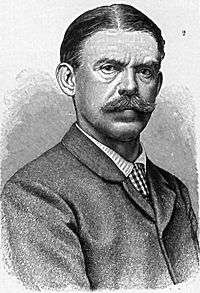Georg August Schweinfurth
| Georg August Schweinfurth | |
|---|---|
|
Georg August Schweinfurth | |
| Born |
August 30, 1836 Riga, Latvia |
| Died | November 19, 1925 (aged 89) |
| Nationality | Baltic German |
| Fields | botany |
| Notable awards |
Vega Medal (1899) Founder's Gold Medal of RGS (1874) |
Georg August Schweinfurth (December 29, 1836 – September 19, 1925) was a Baltic German botanist, traveller in East Central Africa and ethnologist.
He was born at Riga, Latvia, then part of the Russian Empire. He was educated at the universities of Heidelberg, Munich and Berlin (1856–1862), where he particularly devoted himself to botany and palaeontology. Commissioned to arrange the collections brought from the Sudan by Freiherr von Barnim and Dr Hartmann, his attention was directed to that region; and in 1863 he travelled round the shores of the Red Sea, repeatedly traversed the district between that sea and the Nile, passed on to Khartoum, and returned to Europe in 1866.
His researches attracted so much attention that in 1868 the Humboldt-Stiftung of Berlin entrusted him with an important scientific mission to the interior of East Africa. Starting from Khartoum in January 1869, he went up the White Nile to Bahr-el-Ghazal, and then, with a party of ivory dealers, through the regions inhabited by the Diur (Dyoor), Dinka, Bongo and Niam-Niam; crossing the Congo-Nile watershed he entered the country of the Mangbetu (Monbuttu) and discovered the river Uele (March 19, 1870), which by its westward flow he knew was independent of the Nile. Schweinfurth formed the conclusion that it belonged to the Chad system, and it was several years before its connection with the Congo was demonstrated.
The discovery of the Uele was Schweinfurth's greatest geographical achievement, though he did much to elucidate the hydrography of the Bahr-el-Ghazal system. Of greater importance were the very considerable additions he made to the knowledge of the inhabitants and of the flora and fauna of Central Africa. He described in detail the cannibalistic practices of the Mangbetu, and his discovery of the pygmy Akka settled conclusively the question as to the existence of dwarf races in tropical Africa. Unfortunately nearly all his collections made up to that date were destroyed by a fire in his camp in December 1870. He returned to Khartoum in July 1871 and published an account of the expedition, under the title of Im Herzen von Afrika (Leipzig, 1874; English edition, The Heart of Africa, 1873, new ed. 1878).
In 1873-1874 he accompanied Friedrich Gerhard Rohlfs in his expedition into the Libyan Desert. Settling at Cairo in 1875, he founded a geographical society, under the auspices of the khedive Ismail, and devoted himself almost exclusively to African studies, historical and ethnographical. In 1876 he penetrated into the Arabian Desert with Paul Güssfeldt, and continued his explorations therein at intervals until 1888, and during the same period made geological and botanical investigations in the Fayum, in the valley of the Nile. In 1889 he removed to Berlin; but he visited the Italian colony of Eritrea in 1891, 1892 and 1894. Schweinfurth died in Berlin.
The accounts of all his travels and researches have appeared either in book or pamphlet form or in periodicals, such as Petermanns Mitteilungen, the Zeitschrift für Erdkunde. Among his works may be mentioned Artes Africanae; Illustrations and Descriptions of Productions of the Industrial Arts of Central African Tribes (1875).
See also
References
- Attribution
 This article incorporates text from a publication now in the public domain: Chisholm, Hugh, ed. (1911). "Schweinfurth, Georg August". Encyclopædia Britannica (11th ed.). Cambridge University Press.
This article incorporates text from a publication now in the public domain: Chisholm, Hugh, ed. (1911). "Schweinfurth, Georg August". Encyclopædia Britannica (11th ed.). Cambridge University Press.
External links
![]() Media related to Georg August Schweinfurth at Wikimedia Commons
Media related to Georg August Schweinfurth at Wikimedia Commons
![]() Data related to Georg August Schweinfurth at Wikispecies
Data related to Georg August Schweinfurth at Wikispecies
- Georg August Schweinfurth at Britannica.com
- Author Query Results and Plant Name Query Results for Georg August Schweinfurth at the International Plant Names Index. Retrieved on February 23, 2009.
- The Heart of Africa. Three years’ travels and adventures in the unexplored regions of Central Africa from 1868 to 1871. By Dr. Georg Schweinfurth. Translated by Ellen E. Frewer. With an Introduction by Winwood Reade. 1874.
- Works by or about Georg August Schweinfurth at Internet Archive
- Works by Georg August Schweinfurth at LibriVox (public domain audiobooks)

